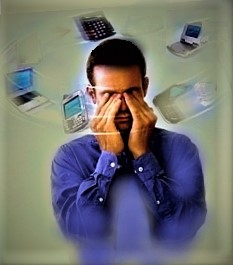Digital Eye Strain
What is Digital Eye Strain?
On average, more than nine in 10 adults (93.3 percent) spend more than two hours each day using a digital device, with more than six in 10 adults (60.8 percent) spending five or more hours on digital devices each day. Whether it's for work or play, using computers, smart phones, tablets and e-readers TV or video games, all that time can take a toll on the eyes and lead to digital eye strain.
Digital eye strain is the physical discomfort felt after two or more hours in front of a digital screen and is associated with the close to mid-range distance of digital screens, including desktop and laptop computers, tablets, e-readers and cell phones. On average, a person going through his or her daily routine blinks about 18 times per minute. However, spending significant amounts of time staring at a screen causes blink rates to reduce, resulting in dry, itchy or burning eyes.
Adults with computer-oriented jobs feel the strain most acutely. A 2018 study found that office workers who spend significant time in front of computer screens and experience eyestrain undergo changes in tear fluid similar to people with dry eye disease, creating a physiological change.
Tools are available to help technology users alleviate the discomfort of digital eyestrain, maintain vision health and prevent further eye discomfort. When used in tandem with practical "eye-gonomic" health tips, lenses tailored for digital screen use (computer eyewear) can reduce or even prevent digital eyestrain.
What Can You Do to Prevent Digital Eye Strain?
Just like people need different pairs of shoes for different occasions, there is also a need for different, specialized lenses to cater to varied vision needs. To accommodate how much lives have changed in the decade with digital devices, the optical industry has developed lens treatments that limit the amount of blue light penetrating eyes while also preventing vision fatigue caused by prolonged use of technology.
Computer eyewear is specially designed for optimizing vision when viewing content on screens and can be provided with or without a prescription. This eyewear can utilize different filters, lenses and materials tailored to lifestyle needs. Users experience more relaxation, sharper focus and reduced blurriness and pixilation, which can cause discomfort unless corrected. The lens designs allow adults and children's eyes to relax, adjusting to intermediate-distance objects and reducing glare during prolonged use of digital devices.
One of the most popular lens options is the anti-reflective, or AR, lens, which decreases reflection from overhead lighting to improve acuity and contrast. These specialized lenses can be combined with blue light-blocking capabilities. Blue light-blocking lenses selectively absorb harmful blue light, keeping it from entering through the cornea and reaching the back of the eye. These lenses are either infused with melanin or made to filter a specific range of blue light.
When examining the best options, consumers should take into consideration the amount of time spent in front of their computer, ambient lighting conditions, distance from their computer and the type of computer work being done. Consider if there are short bursts of computer work interspersed with meetings or other activities away from the desk. This will help determine between the need for lenses that offer a very wide, but shallow field of view (ideal for sustained computer work) and one that offers good computer vision but also lets you see clearly wherever you are inside the workplace.

Digital eye strain is the physical eye discomfort felt by many individuals after two or more hours in front of a digital screen